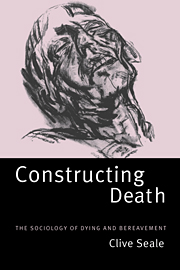8 - Awareness and control of dying
Published online by Cambridge University Press: 28 October 2009
Summary
Everyday social life is permeated by the moment-to-moment construction and negotiation of memberships as conversation analysts have shown. The roots of the desire for membership which, I argued in chapter 1, are hardly analysed in social theory, lie in the fundamental fact of human embodiment. This means that we live at every moment with the (albeit repressed) knowledge of our deaths. Our clinging together in membership is supported by institutionally organised cultural scripts that enable us to order our personal narratives of selfidentity, even in the face of dying and bereavement, so that an intact social bond is preserved. In late modern cultures, as we have seen, medicine and revivalism make two important scripts available. In this chapter I shall show how people write themselves into cultural scripts that preserve an intact social bond when close to death.
The fall from culture as the body fails and the self withdraws from the social bond, described in the previous chapter, is resisted in various ways as people seek to imbue their doying trajectories with meaning. Taking control over the manner and timing of one's own death, as when a person decides to fast to death, is one way of preserving a meaningful social existence until death. It means the avoidance of a lingering social death, involving declining abilities to manage the project of self-identity as dependency on others for care increases with a growing, painful awareness of a declining capacity for membership.
- Type
- Chapter
- Information
- Constructing DeathThe Sociology of Dying and Bereavement, pp. 172 - 192Publisher: Cambridge University PressPrint publication year: 1998

